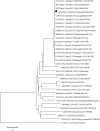Nearly complete genome sequence of one GII.17 Norovirus identified by direct sequencing from HuZhou, China
- PMID: 29992776
- PMCID: PMC6160709
- DOI: 10.1002/mgg3.446
Nearly complete genome sequence of one GII.17 Norovirus identified by direct sequencing from HuZhou, China
Abstract
Background: Human norovirus is the leading cause of acute gastroenteritis worldwide. However, in vitro culture system is complicated for human norovirus. Sequence analysis became more useful for norovirus research, particularly when using complete genomic sequences.
Methods: Real-time RT-PCR (qPCR) was performed for norovirus detection. Three modified paris of PCR primes were designed based on the alignment of the novel GII.17 norovirus complete sequence available in Genbank., which could amplify three overlapping fragments cover the whole genome. The PCR fragments were sequencing by Sanger sequence with Primer walking methods. Genogroup and genotype were assigned using the Norovirus Noronet typing tool and the strains were named according to the time of isolation. The phylogenetic analysis was conducted using MEGA software (ver. 6.06).
Results: One nearly complete genome sequence were obtained from sample collected from Huzhou, China. The partial genome sequence of the HuzhouNS2014603 strain is composed of 7556 nucleotides (nt).The strain was classified as GII.17 genotype both in ORF1 and ORF2, and was most closely related to the LC037415.1/Hu/GII.17/Kawasaki308 strain. Within the GII.17 cluster, the 2013/14 season strains were grouped separately from the GII.17 strains detected in 2014/15. HuzhouNS2014603 was clustered with the 2014/15 season strains. Compared with other strains selected, there are 98 variable residues across the VP1 domain. Among the 98 variable amino acids, 13 (13.3%) were observed in the shell domain and 22 (22.4%) in the P1domain; most of the substitutions and insertions were located in the P2 domain, account for 63 (64.3%).
Conclusions: This is the first report of the nearly complete genome of the novel GII.17 by direct sequencing method in the Huzhou area. The results of this study could be helpful for the study of the genetic evolution of the virus, the development of rapid diagnostic reagents and the design of vaccine.
Keywords: GII.17; complete genome; genetic analysis; norovirus.
© 2018 The Authors. Molecular Genetics & Genomic Medicine published by Wiley Periodicals, Inc.
Figures




References
Publication types
MeSH terms
Associated data
- Actions
- Actions
- Actions
- Actions
- Actions
- Actions
- Actions
- Actions
- Actions
- Actions
- Actions
- Actions
- Actions
- Actions
- Actions
- Actions
- Actions
- Actions
- Actions
- Actions
- Actions
- Actions
- Actions
- Actions
- Actions
- Actions
- Actions
- Actions
- Actions
- Actions
- Actions
- Actions
- Actions
- Actions
- Actions
- Actions
- Actions
- Actions
- Actions
- Actions
- Actions
- Actions
- Actions
- Actions
- Actions
- Actions
- Actions
- Actions
- Actions
- Actions
- Actions
- Actions
- Actions
Grants and funding
LinkOut - more resources
Full Text Sources
Other Literature Sources
Medical
Research Materials

